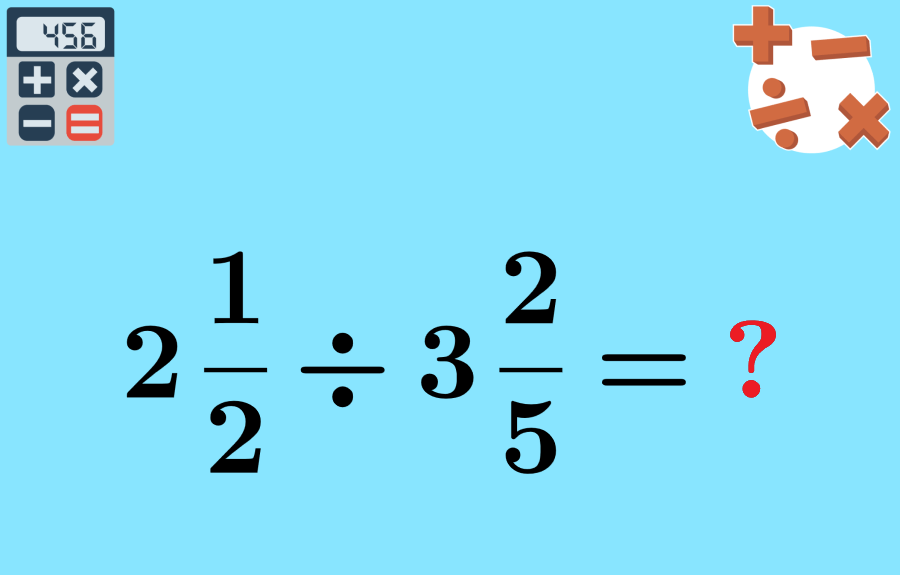We can divide two or more mixed fractions by converting the mixed fractions or whole numbers to improper fractions. Then, we convert the division to multiplication by taking the reciprocal of the dividing fraction. Finally, we multiply the numerators and denominators separately and simplify the final fraction.
Here, we will learn how to divide fractions with whole numbers. In addition, we will solve some practice problems to apply everything learned.
Steps to divide fractions with whole numbers
Remember that mixed fractions have two parts, a whole part, and a fractional part. On the other hand, improper fractions only have a fractional part.
Mixed fractions or whole numbers can be converted to improper fractions and vice versa. Therefore, we follow the following steps to divide fractions with whole numbers:
Step 1: Convert mixed fractions or whole numbers to improper fractions.
- To convert whole numbers to improper fractions, we write 1 as the denominator. For example, $latex 2=\frac{2}{1}$.
- To convert mixed fractions to improper fractions, we multiply the integer part by the denominator and add the result to the numerator.
Step 2: Take the reciprocal of the dividing fraction.
We find the reciprocal of a fraction simply by turning it over. Thus, we swap the numerator and denominator.
Step 3: Change the division sign to multiplication.
Step 4: Multiply the numerators.
Step 5: Multiply the denominators.
Step 6: Simplify the final fraction if possible.
Dividing fractions with whole numbers – Examples with answers
The following examples are solved by applying the steps for dividing fractions with whole numbers seen above. Try to solve the problems yourself before looking at the solution.
EXAMPLE 1
Solve the division of fractions $latex 1\frac{1}{2}\div \frac{2}{3}$.
Solution
Step 1: Converting the mixed fraction to an improper fraction, we have:
$$1\frac{1}{2}\div \frac{2}{3}$$
$$=\frac{3}{2}\div \frac{2}{3}$$
Step 2: The dividing fraction is $latex \frac{2}{3}$. Its reciprocal is:
$$\frac{3}{2}$$
Step 3: Writing the division as multiplication, we have:
$$=\frac{3}{2}\times \frac{3}{2}$$
Step 4: Multiplying the numerators, we have:
$$\frac{3\times 3}{2\times 2}$$
$$=\frac{9}{2\times 2}$$
Step 5: Multiplying the denominators, we have:
$$=\frac{9}{4}$$
Step 6: Writing as a mixed fraction, we have:
$$=1\frac{3}{4}$$
EXAMPLE 2
Find the result of the division $latex \frac{5}{9}\div 4$.
Solution
Step 1: We convert the whole number to a fraction:
$$\frac{5}{9}\div 4$$
$$=\frac{5}{9}\div \frac{4}{1}$$
Step 2: The reciprocal of the dividing fraction, $latex \frac{4}{1}$, is:
$$\frac{1}{4}$$
Step 3: Writing the division as multiplication, we have:
$$=\frac{5}{9}\times \frac{1}{4}$$
Step 4: By multiplying the numerators, we have:
$$\frac{5\times 1}{9\times 4}$$
$$=\frac{5}{9\times 4}$$
Step 5: By multiplying the denominators, we have:
$$=\frac{5}{36}$$
Step 6: The fraction is now simplified.
EXAMPLE 3
Solve the division of fractions $latex 2\frac{4}{5}\div 1\frac{1}{7}$.
Solution
Step 1: We convert both mixed fractions to improper fractions, and we have:
$$2\frac{4}{5}\div 1\frac{1}{7}$$
$$=\frac{14}{5}\div \frac{8}{7}$$
Step 2: The dividing fraction is $latex \frac{8}{7}$. Its reciprocal is:
$$\frac{7}{8}$$
Step 3: We use the reciprocal of the divisor fraction and write the division as multiplication:
$$=\frac{14}{5}\times \frac{7}{8}$$
Step 4: Multiplying the numerators, we have:
$$\frac{14\times 7}{5\times 8}$$
$$=\frac{98}{5\times 8}$$
Step 5: Multiplying the denominators, we have:
$$=\frac{98}{40}$$
Step 6: We simplify by dividing by 2 and writing as a mixed fraction:
$$=\frac{49}{20}$$
$$=2\frac{9}{20}$$
EXAMPLE 4
Solve the division of mixed fractions $latex 2\frac{2}{3} \div 1\frac{2}{5}$.
Solution
Step 1: Converting both mixed fractions to improper fractions, we have:
$$2\frac{2}{3}\div 1\frac{2}{5}$$
$$=\frac{8}{3}\div \frac{7}{5}$$
Step 2: The reciprocal of the dividing fraction, $latex \frac{7}{5}$, is:
$$\frac{5}{7}$$
Step 3: Using the reciprocal of the dividing fraction, we write the division as multiplication, we have:
$$=\frac{8}{3}\times \frac{5}{7}$$
Step 4: By multiplying the numerators, we have:
$$\frac{8\times 5}{3\times 7}$$
$$=\frac{40}{3\times 7}$$
Step 5: By multiplying the denominators, we have:
$$=\frac{40}{21}$$
Step 6: Writing as a mixed fraction, we have:
$$=1\frac{19}{21}$$
EXAMPLE 5
Solve the division of mixed fractions $latex 2\frac{1}{3}\div \frac{2}{7}\div 2$.
Solution
Step 1: Converting the mixed fraction to an improper fraction and the whole number to a fraction, we have:
$$2\frac{1}{3}\div \frac{2}{7}\div 2$$
$$=\frac{7}{3}\div \frac{2}{7} \div \frac{2}{1}$$
Step 2: We have two dividing fractions. The reciprocal of $latex \frac{2}{7}$ is $latex \frac{7}{2}$ and the reciprocal of $latex \frac{2}{1}$ is $latex \frac{1}{ 2}$.
Step 3: Using the reciprocals of the dividing fractions, we write the division as multiplication:
$$=\frac{7}{3}\times \frac{7}{2} \times \frac{1}{2}$$
Step 4: Multiplying the numerators, we have:
$$\frac{7\times 7 \times 1}{3\times 2 \times 2}$$
$$=\frac{49}{3\times 2 \times 2}$$
Step 5: Multiplying the denominators, we have:
$$=\frac{49}{12}$$
Step 6: Writing as a mixed fraction, we have:
$$=4\frac{1}{12}$$
EXAMPLE 6
Solve the division of fractions $latex 2\frac{3}{4} \div 1\frac{2}{3}\div 1\frac{2}{5}$.
Solution
Step 1: We convert both mixed fractions to improper fractions:
$$2\frac{3}{4} \div 1\frac{2}{3}\div 1\frac{2}{5}$$
$$=\frac{11}{4} \div \frac{5}{3}\div \frac{7}{5}$$
Step 2: The reciprocal of $latex \frac{5}{3}$ is $latex \frac{3}{5}$ and the reciprocal of $latex \frac{7}{5}$ is $latex \frac{ 5}{7}$.
Step 3: Writing division as multiplication, we have:
$$=\frac{11}{4}\times \frac{3}{5} \times \frac{5}{7}$$
Step 4: By multiplying the numerators, we have:
$$\frac{11\times 3 \times 5}{4\times 5 \times 7}$$
$$=\frac{165}{4\times 5 \times 7}$$
Step 5: By multiplying the denominators, we have:
$$=\frac{165}{140}$$
Step 6: Simplifying and writing as a mixed fraction, we have:
$$=\frac{33}{28}$$
$$=1\frac{5}{28}$$
Dividing fractions with whole numbers – Practice problems
Solve the following problems to practice everything you have learned about dividing fractions with whole numbers.
See also
Interested in learning more about multiplying and dividing fractions? Take a look at these pages:




